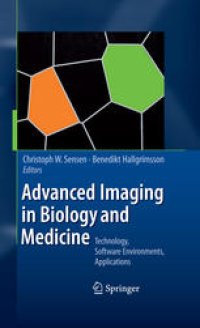
Ebook: Advanced Imaging in Biology and Medicine: Technology, Software Environments, Applications
- Tags: Imaging / Radiology, Biomedicine general
- Year: 2009
- Publisher: Springer-Verlag Berlin Heidelberg
- Edition: 1
- Language: English
- pdf
Since the invention of X-Ray technology by Konrad Roentgen in 1895, non-invasive imaging technologies are part of the medical and biological tool kit. Today, quite a number of non-invasive imaging technologies exist, from 4-dimensional Ultrasound to Computer Tomography. Almost every individual is subjected to one or more of these technologies during their lifetime. Destructive imaging approaches such as light- and electron microscopy have benefitted from the development of computing algorithms and digital imaging, making them more and more valuable for the study of biological and medical phenomena.
Not only is the number of imaging technologies increasing rapidly, at the same time the strategies and algorithms for image analysis are becoming more and more sophisticated. This book attempts for the first time to provide an overview of the major approaches to biological and medical imaging, the strategies for image analysis and the creation of models, which are based on the results of image analysis. This sets the book aside from the usual monographs, which introduce the reader only to a single technology.
Given the broad range of topics covered, this book provides an overview of the field, which is useful for a wide audience, from physicians and biologists to readers who would like to know more about the technology, which is used to derive diagnoses of diseases today.
Since the invention of X-Ray technology by Konrad Roentgen in 1895, non-invasive imaging technologies are part of the medical and biological tool kit. Today, quite a number of non-invasive imaging technologies exist, from 4-dimensional Ultrasound to Computer Tomography. Almost every individual is subjected to one or more of these technologies during their lifetime. Destructive imaging approaches such as light- and electron microscopy have benefitted from the development of computing algorithms and digital imaging, making them more and more valuable for the study of biological and medical phenomena.
Not only is the number of imaging technologies increasing rapidly, at the same time the strategies and algorithms for image analysis are becoming more and more sophisticated. This book attempts for the first time to provide an overview of the major approaches to biological and medical imaging, the strategies for image analysis and the creation of models, which are based on the results of image analysis. This sets the book aside from the usual monographs, which introduce the reader only to a single technology.
Given the broad range of topics covered, this book provides an overview of the field, which is useful for a wide audience, from physicians and biologists to readers who would like to know more about the technology, which is used to derive diagnoses of diseases today.